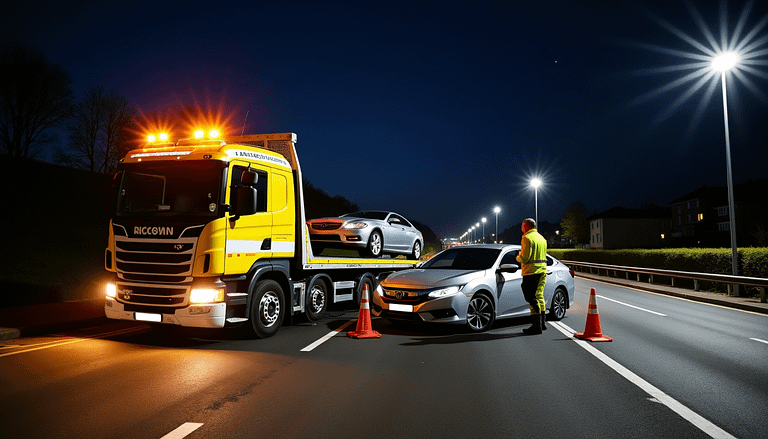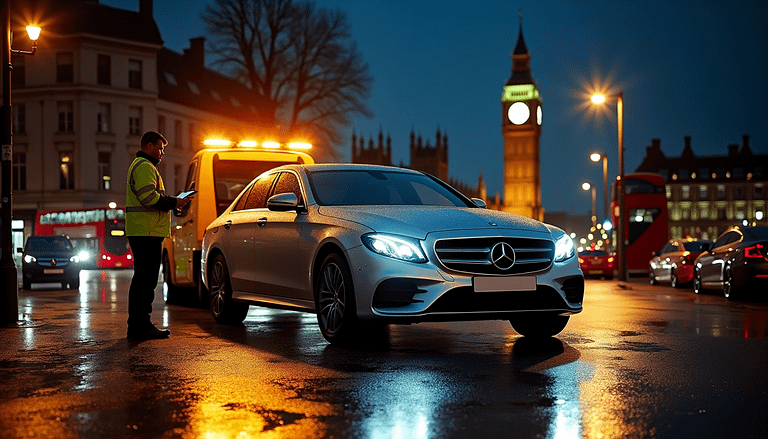The Ultimate Guide to Breakdown Recovery: Everything You Need to Know in 2025
Most drivers never need roadside assistance – only 12% call for help. But breakdowns can leave you feeling helpless and anxious when they occur.
The right breakdown recovery service makes a significant difference, with costs ranging from £21 to £135.
Choosing the right breakdown cover can feel daunting with numerous options in the market. We created a complete guide to breakdown recovery that covers your needs. You’ll learn how to select the best service and what steps to take when your vehicle stops working.
Let’s take a closer look at breakdown recovery services to help you stay safe and confident on the road.
Understanding Breakdown Recovery Services
Breakdown recovery services help you when your vehicle has mechanical problems. These services have many assistance options from roadside repairs to detailed recovery solutions.
The core service gives you access to trained mechanics who fix common problems like flat batteries, punctured tires, or engine issues. Your vehicle will be towed to a nearby garage if repairs aren’t possible on the roadside.
You can pick from two main types of breakdown cover:
- Personal Cover: This option protects you as a driver and passenger in any eligible vehicle. The coverage extends to include up to five people living in the same household.
- Vehicle Cover: This type protects a specific vehicle, whatever the driver’s identity at breakdown time. Most providers let you cover up to three vehicles under one policy.
The breakdown services come in these categories:
- Roadside Assistance: This simple level of service helps when you break down more than a quarter mile from home. A mechanic tries to fix your car on-site and tows it to a nearby garage if repairs don’t work.
- At Home Recovery: Also called Home Start, this service covers breakdowns at your home or within a quarter mile of your address.
- National Recovery: This improved service can transport your vehicle, you, and up to seven passengers to any single UK destination if roadside repairs aren’t possible.
- Onward Travel: This detailed option will give a way to reach your destination despite a breakdown. You get a hire car for up to three days, overnight accommodation, or alternative transport costs.
Most providers give unlimited callouts throughout the year, as long as they’re not for the same problems. Many services now employ advanced technology for faster response times. Providers usually reach stranded motorists within an hour.
Simple policies don’t cover certain situations like breakdowns on private property, routine maintenance, and human errors like misfueling or leaving lights on. Understanding these exclusions helps you choose the right coverage that fits your needs.
Choosing the Right Breakdown Cover
You need to think about several things to get the best value from your breakdown cover. Simple policies cost around £20 per year, while detailed coverage could set you back £120 for UK-wide protection.
Let’s get into whether you already have coverage. Most new cars come with breakdown assistance built into their warranty that lasts three years or more. On top of that, premium bank accounts and credit cards sometimes include breakdown coverage as a bonus.
Here are the key things to look at when choosing providers:
- Coverage Type: Personal cover keeps you protected in any eligible vehicle, even as a passenger. Vehicle-based coverage protects a specific car whatever the driver’s identity. Families with multiple drivers using one car usually find vehicle coverage more budget-friendly.
- Service Network: Big names like the AA and RAC have their own patrol vehicles to ensure quality service stays consistent. Other providers work with independent garage networks, which might serve remote areas better.
- Price Transparency: Choose providers who show clear costs without hidden charges. Some companies add extra fees for equipment maintenance or setup that can substantially increase your total costs.
Your driving habits determine how much coverage you need. To cite an instance, see if you stay close to home – nationwide recovery might be overkill. But if you’re often on long trips, you should look at detailed coverage with travel options.
GEM Motoring Assist gives you unlimited callouts with detailed coverage, including home assistance and nationwide recovery. LV Britannia Rescue keeps customer satisfaction high despite recent market shifts.
Note that breakdown companies usually raise their premiums at renewal time, but they’ll often lower prices if you challenge them. You’ll also save money by paying annually instead of monthly.
Planning European trips? Continental coverage might help – it costs between £80 and £150 yearly. This option becomes budget-friendly especially when you plan longer stays or multiple trips abroad.
What to Do When Your Vehicle Breaks Down
Your quick thinking and safety measures can save lives during a vehicle breakdown. The right steps will protect you and your passengers from danger.
On Regular Roads:
Pull your vehicle to a safe spot away from traffic, preferably a layby or parking area. Turn on your hazard warning lights right away. Poor visibility requires your sidelights too. Set up a warning triangle at least 45 meters behind your vehicle to warn other drivers. This doesn’t apply to motorways where it’s unsafe.
On Motorways:
- Take the next available junction or service area if you can
- The hard shoulder or emergency refuge area works if you can’t exit
- Park your vehicle far left with wheels turned left
- Use hazard lights and sidelights when visibility is poor
Essential Safety Steps:
- Leave only through the left-hand doors
- Put on high-visibility clothing if you have it
- Stay behind safety barriers away from traffic
- Keep your pets inside the vehicle
Contacting Assistance:
Know your exact location before calling help. Look for driver location signs on motorways or use emergency phones that connect to highway authorities. Most breakdown services provide mobile apps to locate you quickly.
Special Circumstances:
Night breakdowns and bad weather need extra caution. The hard shoulder isn’t safe – don’t go back to your vehicle while waiting. Disabled drivers or people with mobility issues should stay buckled up in their vehicle with hazard lights on and call emergency services.
Important Safety Notes:
- Skip repairs on motorways
- Keep seatbelts on and dial 999 if stuck in a live lane
- Lock all doors and stay inside if you feel threatened
- Don’t stand between your vehicle and traffic
Let your breakdown service know if you’re alone or have vulnerable passengers – this could speed up their response. Service providers typically reach you within an hour to fix your vehicle or tow it to a nearby garage.
Conclusion
Breakdown recovery services provide a vital safety net that every driver needs, though most drivers rarely use them. Smart choices about available options help match both your driving habits and budget.
Simple roadside assistance is enough for city drivers who stay close to home. But complete coverage with national recovery and onward travel benefits works better for those who drive long distances. Your personal circumstances and driving patterns should determine the right choice.
Your safety matters most during breakdowns. Quick thinking and proper safety measures combined with immediate contact to your recovery provider reduce risks and stress by a lot. Professional help arrives faster when you know your coverage details and emergency contacts.
The right mix of coverage types, service networks, and pricing structures guides you toward better road protection. Breakdown coverage might look like an extra cost, but the protection and peace of mind make it worth the investment for any driver.
FAQs
Q1. What types of breakdown cover are available in 2025? There are two main types: Personal Cover, which protects you as a driver or passenger in any eligible vehicle, and Vehicle Cover, which safeguards a specific vehicle regardless of who’s driving. Coverage options include Roadside Assistance, At Home Recovery, National Recovery, and Onward Travel.
Q2. How much does breakdown cover typically cost? The cost of breakdown cover varies widely, ranging from about £20 annually for basic policies to around £120 for comprehensive UK-wide protection. Prices depend on the level of coverage, provider, and whether you opt for personal or vehicle-based cover.
Q3. What should I do if my vehicle breaks down on a motorway? If possible, exit at the next junction or service area. If not, pull onto the hard shoulder or emergency refuge area, position your vehicle as far left as possible, and turn on your hazard lights. Exit through the left-hand doors, wear high-visibility clothing if available, and stand behind safety barriers away from traffic.
Q4. Are there any situations not covered by basic breakdown policies? Yes, basic policies typically exclude breakdowns on private property, routine maintenance issues, and human errors like misfueling or leaving lights on. It’s important to understand these exclusions when choosing your coverage.
Q5. How quickly can I expect help to arrive after calling for breakdown assistance? Most providers aim to reach stranded motorists within an hour. Some leading companies, like LV Britannia, can reach up to 26% of stranded motorists within 30 minutes, which is better than the industry average of 21%.





